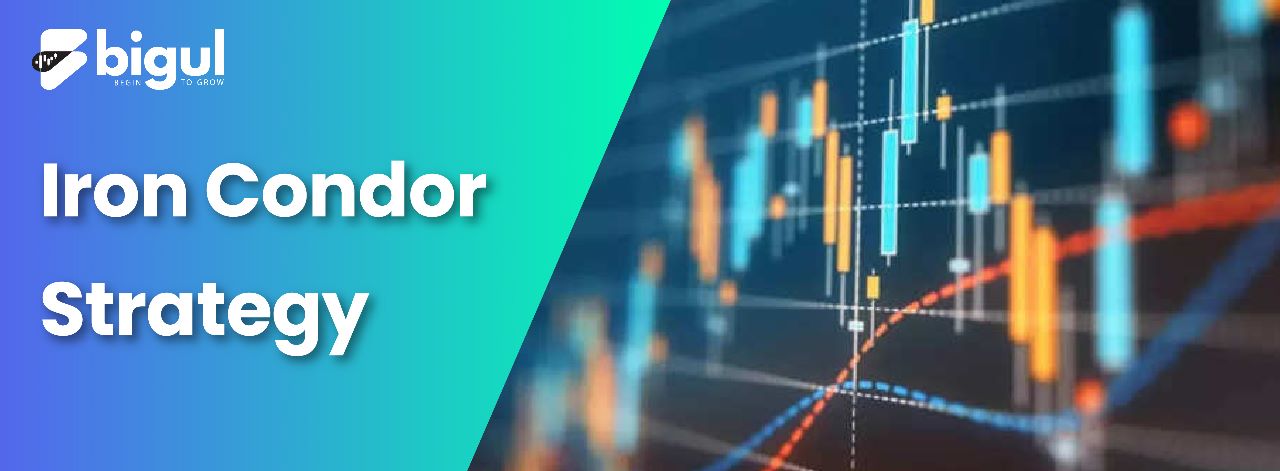Discover the iron condor option strategy, a limited-risk approach that allows traders to benefit from low-volatility markets. With numerous options trading strategies available, some entail higher risks, but the iron condor is a safer choice.
In this article, we will dive into the fundamentals of this technique, offering a straightforward explanation for traders of all levels. Learn how to confidently navigate the financial markets using the iron condor strategy and capitalize on favourable trading opportunities.
What Is an Iron Condor?
The iron condor option strategy is a popular strategy. It involves two long and two short positions on puts and calls with the same expiration date and four strike prices. The objective is to capitalize on low volatility in the underlying asset, leading to maximum profit if the asset closes between the middle strike prices at expiration.
Like the regular condor spread, the iron condor’s payoff varies but with added flexibility, as it combines calls and puts. Both strategies are extensions of the butterfly spread and iron butterfly, respectively.
Understanding an Iron Condor
The iron condor strategy offers limited risk as the high and low strike options act as protective wings against major market moves. While this caps the profit potential, the trader aims for all options to expire worthlessly by having the underlying asset close between the middle two strike prices at expiration.
If successful, a fee might be incurred to close the trade, but even if unsuccessful, losses remain restricted. To construct an iron condor, consider four alternatives with the same expiration date. Follow these steps to build this options trading strategy effectively.
- Buy one out of the money (OTM) put with a strike price below the current asset price.
- Sell one OTM or at the money (ATM) put with a strike price closer to the current asset price.
- Sell one OTM or ATM call with a strike price above the current asset price.
- Buy one OTM call with a strike price above the current asset price.
In the iron condor strategy, the outer options, known as wings, are long positions placed further out-of-the-money (OTM). The trade results in a net credit to the account as their premiums are lower than the written options. Adjusting the strike prices can make the strategy either bullish or bearish, offering flexibility to suit market expectations.
Iron Condor Profits and Losses
An Iron Condor is a risky options strategy with a capped maximum profit and loss potential. Long options hedge the risk of short options in case the spread moves in the money (ITM). The net credit received upfront represents the strategy’s greatest profit potential. If the underlying settles between the short strikes at expiration, all options expire worthless, maximising profit.
However, traders can exit the trade early if they achieve a 50% profit (e.g., when the spread is trading for 50% of the credit received) by routing the opposite order or “buying back” the Iron Condor using the same strikes and expiration cycle
Example of an Iron Condor
An Iron Condor is an options trading strategy that combines two vertical spreads. It is designed to profit from low volatility in the underlying asset. The strategy gets its name from the shape of the profit/loss graph, which resembles the wings of a condor.
Let’s assume that the underlying asset is a stock trading in the Indian stock market, and the prices are given in rupees. For example, let’s consider a hypothetical stock XYZ currently trading at Rs 100.
To create an Iron Condor, you would perform the following steps:
Sell a Call Spread:
- Sell 1 XYZ Call Option with a strike price of Rs 110 for Rs 5.
- Buy 1 XYZ Call Option with a strike price of Rs 120 for Rs 2.
Sell a Put Spread:
- Sell 1 XYZ Put Option with a strike price of Rs 90 for Rs 4.
- Buy 1 XYZ Put Option with a strike price of Rs 80 for Re 1.
Now, let’s calculate the net premium received:
Net Premium Received = [(Sell Call Premium – Buy Call Premium) + (Sell Put Premium – Buy Put Premium)]
Net Premium Received = [(5 – 2) + (4 – 1)]
Net Premium Received = [3 + 3] = Rs 6
In this example, you would receive a net premium of Rs 6 per share (per lot) when initiating the Iron Condor position.
· Maximum Profit: The maximum profit for an Iron Condor occurs when the underlying stock’s price remains between the strike prices of the two spreads (i.e., Rs 90 and Rs 110). In this case, the maximum profit is the net premium received, Rs 6 per shaRe
· Maximum Loss: The maximum loss occurs if the stock price moves significantly beyond the strike prices of the call spread or the put spread. In this example, the maximum loss would be the difference between the strike prices of either spread (Rs 20) minus the net premium received (Rs 6), multiplied by the lot size.
Are Iron Condors Profitable?
Iron Condors can be profitable in low-volatility market conditions when the underlying asset remains within the chosen range of strike prices.
The strategy aims to generate income through premium collection but also carries limited profit potential and defined risk. Market movements outside the range can lead to losses. Successful Iron Condor trades depend on a skilful selection of strike prices, timing, and proper risk management.
Conclusion
The Iron Condor strategy is an options trading approach designed to profit from low volatility. Combining two vertical spreads aims to generate income through premium collection while managing risk. Traders must carefully select strike prices and consider iron condor adjustments to effectively adapt to changing market conditions. Mastering this strategy requires skill, discipline, and proper risk management.
